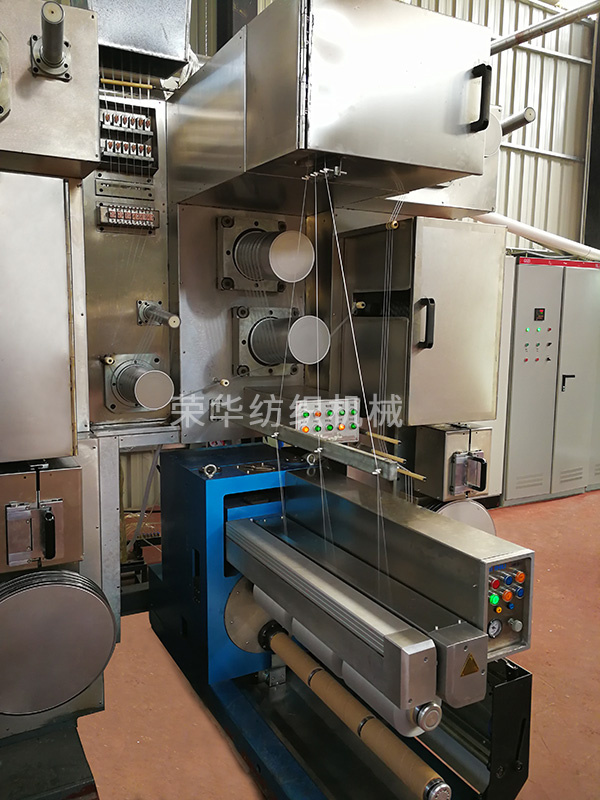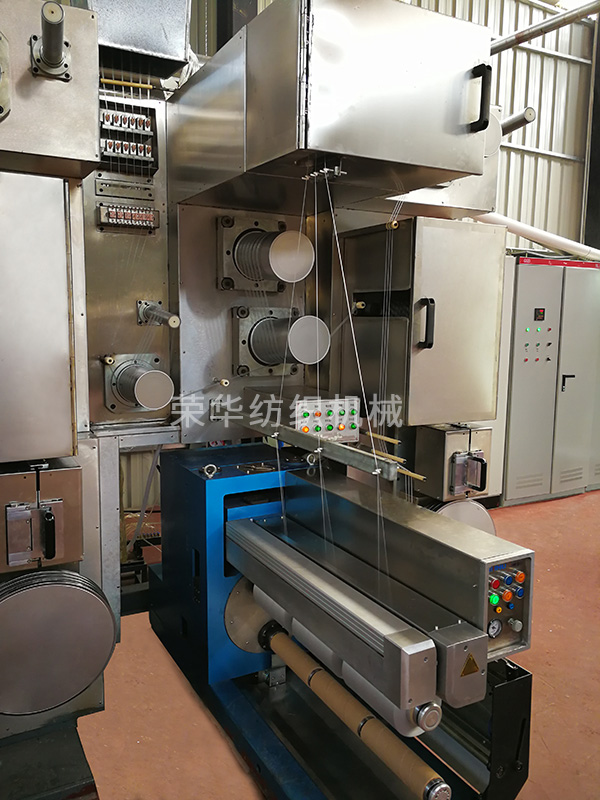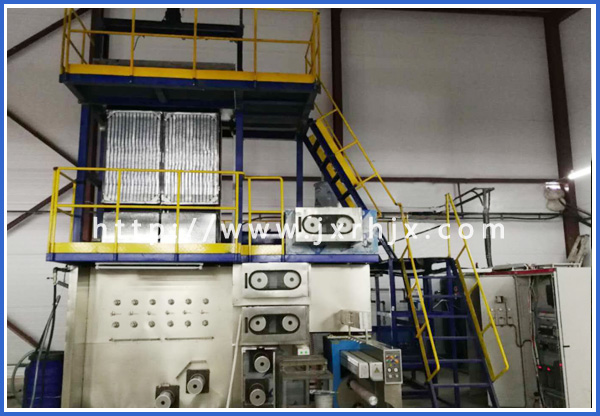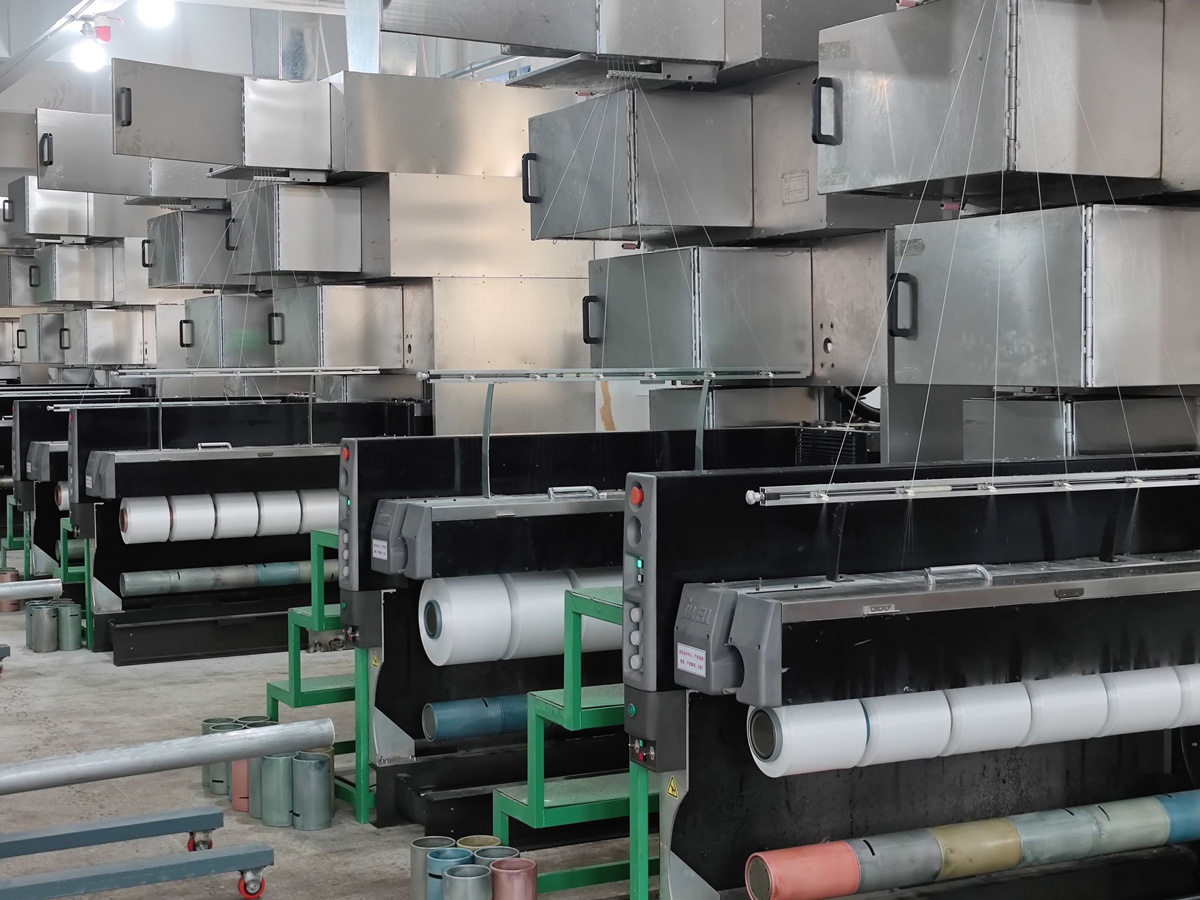- BCF spinning equipment
- Polypropylene high strength FDY spinning equipment
- Polypropylene strong FDY spinning equipment
- Polypropylene machine
- Small testing machine
- Polypropylene staple fiber front spinning equipment
- Polypropylene POY spinning equipment
- Polyester POY spinning equipment
- Hair device
- other devices


- Tel:0086-0794-8585168 / 8251989
- Cel:0086-18907949666 / 13970428918
- E-mail:18907949666@189.cn
- Add:Huoju 6 Road, High-tech Zone, Fuzhou City, Jiangxi Province
A river plumbing duck prophet, as the whole industry before the process flow, sales of textile machinery market is to determine the development trend of the textile industry an important indicator. Serve the transformation and upgrading of the textile industry has become a sharp main line of the development of the current textile machinery industry, textile machinery enterprises in the promotion of equipment technology innovation suited to the needs of the market a lot of effort.
2017, which domestic textile machinery sales better? 2018 will show what kind of development trend? Spinning machinery, printing and dyeing machinery, weaving machinery, knitting machinery, non-woven machinery, chemical fiber machinery six major categories of textile machinery equipment to tell you big data.
Spinning machinery
Spinning machinery sales in the first three quarters of 2017
Statistics of key manufacturing enterprises by China Textile Machinery Association show that in the first three quarters of 2017, the sales volume of carding machines was about 3,410, an increase of 7.57% over the same period of last year; the sales volume of machineries was about 3,178 units, an increase of 35.28% over the same period of the previous year, The sales volume of the leveling device was about 1338 units, accounting for 42.09% of the total. The sales of combing machines were about 955 units, an increase of 9.77% over the same period of last year. The sales volume of roving frames was 1047 units, down 4.82% from the same period of last year, of which, Yarn unit roving machine about 176 units, accounting for 16.81% of the total; cotton spinning machine sales of about 3.07 million, an increase of 2.92%, of which long car (with the doffing device) sales 2.06 million, an increase 12.24%. The proportion of long-haul machines to the total number of spinning machines was 67%. The main machine sales of concentrating spinning machines were about 1.48 million, accounting for 48.2% of the total sales of spinning machines. The aggregate sales of spinning machines totaled 3.78 million, down YoY 10.07%; sales of rotor spinning machine about 340,000, an increase of 34.30%; automatic winder sales of about 45 units, an increase of 37.58%.
Operational analysis
Since 2017, all spinning machinery enterprises continue to exert their own technological advantages to promote the use of the latest technologies. The products (systems) including the thickness of the joint smart spinning production line, high-precision traveler, high-precision steel ring and other products through the scientific and technological achievements identification, the main Technical performance have reached the international advanced level. A number of spinning machinery and equipment manufacturing enterprises official said the company's product orders have increased, many companies and even orders to "do it better," the annual operating data of the industry also confirmed the market rebound.
Jingwei Yuci ultra-long intelligent collective doffing spinning machine JWF1580
Jingwei Yuci ultra-long intelligent collective doffing spinning machine JWF1580.
As can be seen from the statistics, the growth of ring spinning machines slowed down while the sales of long vehicles (equipped with collective doffing devices) steadily increased, indicating that the market demand for automation and labor reduction continued to grow. The increase in the proportion of gathering spinning frames in the main frame of the spinning frame shows that the spinning mode and yarn quality of cluster spinning have been approved by most users. Rotor spinning machine has a larger growth year on year, indicating that customers pay more attention to equipment adaptability to raw materials, reduce spinning costs, improve production efficiency.
In addition, since 2017, all spinning machinery enterprises continue to exert their technological advantages and promote the application of the latest technologies. The China Textile Machinery Association organized the appraisal of scientific and technological achievements of new products for many spinning equipment and special equipment enterprises. The combination of thickness, intelligent spinning production line, high-precision bead rings and high-precision steel rings and other products (systems) have passed the scientific and technological achievements appraisal, the main technical performance has reached the international advanced level, and a certain momentum has been continuously injected into the operation of the industry.
Trend forecast
As textile enterprises demand higher and higher yarn quality, as well as labor costs continue to increase, spinning machinery in the intelligent way to accelerate forward. On the basis of improving the quality and reliability of equipment manufacturing, continuous and intelligent are the major trends in the development of spinning machinery and equipment. Industry experts say spinning machines are not only intelligent on a single machine, but rather an unmanned link across the entire spinning process.
In recent years, complete sets of cotton spinning equipment continue to high-yield, high-speed, automated, continuous, information-oriented direction. The monitoring and management technology based on the Internet platform has been continuously improved and the "spinning smart factory" has taken shape. The spinning machine to achieve the process of production process parameters online detection, automatic control, automatic adjustment and network monitoring, to achieve a high degree of automation of spinning production, with accurate mechanical automatic action instead of textile production in simple repetitive manual operation to achieve cans, rovings And combed lap automatic delivery, automatic connector, to achieve online monitoring and intelligent management and remote diagnosis has become the mainstream of the industry.
In 2018, the field of spinning machinery will further increase R & D efforts and develop a new generation of high-end cotton spinning complete sets of equipment to meet the individualized needs of users in terms of refinement, high efficiency, reliability and suitability for spinning. The application of modern information network, digital technology and expert system will continue to be carried out to gradually realize the on-line inspection, display, automatic control, automatic adjustment and network monitoring of textile process parameters. On the other hand, there will be more room for further development of the continuous spinning process, with the automatic conveying of cans, rovings and combed lap and the functions of automatic joints, as well as the ability to realize the automatic winding machine Control, winding process Cartridge automatic transport and automatic packaging equipment will be more spinning enterprises welcome.
In addition, the automated warehouse system as the core of the workshop intelligent logistics system will effectively solve the logistics problem of insufficient efficiency, and intelligent logistics system can reduce staff efficiency, greatly reducing labor costs, while accurate and efficient, so that the quality and yield simultaneously improve and help Business transformation and upgrading. The next stage of development, intelligent logistics system will be the depth of integration of business B2B, B2C business platform to help enterprises achieve customized production. And industrial big data integration, better predict the market demand, analyze user needs, the value chain to maximize. Promote supplier collaboration, supply chain integration, the supply chain more efficient and more flexible and agile to adapt to the changing needs of the market.
Textile machinery
It should be noted that, at present, Internet of Things, ERP and other information technology in the whole process of spinning enterprises and industrial chain management level is still relatively low. China still has more than 90% of the spinning equipment has not yet installed production, energy, quality and other online monitoring system, textile information technology market is very broad.
Printing and dyeing and finishing machinery
Printing equipment sales in the first three quarters of 2017
In the first half of 2017, the domestic printing, dyeing and finishing machinery market rebounded, but the environmental protection policy started to be affected in the second half of the year, and the domestic market tended to be cold.
In the first three quarters of 2017, the sales of low-liquor ratio batch dyeing equipment were generally good. The market for rotary screen printing equipment was very competitive. 158 key sampling enterprises were sold, a decrease of 29% from the same period of 2016 and a 17% decrease from 2015, Significant decline. Flat screen printing equipment has been a downward trend, focusing on sample sales of 45 units, down 6% over the same period in 2016, down 40% compared to 2015. Stenter market has been booming demand, the main stenciller production plant sales growth remained at the growth rate remained at about 10%. The continuous sales of pre-processing equipment for the fabric market remained stable.
In the international market, according to the customs statistics, in the first three quarters of 2017, the export value of finishing machinery after printing and dyeing was approximately 454 million U.S. dollars, up 6.15 percentage points over the same period of last year. The import of post-printing finishing equipment was about 356 million U.S. dollars, up 33% year-on-year.
Operational analysis
In the first three quarters of 2017, the investment in fixed assets of projects of more than 5 million yuan in domestic printing and dyeing enterprises decreased by 5.96% as compared with the same period of last year. The slowdown of investment in the downstream market has a significant impact on the sales of printing and dyeing and finishing machinery. In particular, in the second half of 2017, due to the increasingly stringent environmental protection policies, some of the products were greatly affected and the market started to diverge.
Specifically, with continuous improvement of the level of continuous processing equipment for knitted fabrics, the gradual recognition from customers of low-liquor-ratio batch dyeing equipment has maintained a certain increase in sales volume. Rotogravure Printing Equipment As some of the numerical control technologies and technologies for on-line monitoring have been improved and the big screen and printing equipment have been gradually recognized by the market, such equipment is most obviously affected by the environmental protection policy. Apart from some enterprises, Overall sales decline significantly. SinglePass equipment in digital inkjet printing was once a hot spot in the digital printing market due to its fast printing speed and high product added value. However, as a large number of manufacturers are joining in, the competition is getting more and more in the absence of big order support Intense, profits also will be reduced in the second and third quarter, the heat dropped. Stenter wide range of applications, the processing of objects from the fabric gradually extended to knitted fabrics, non-woven fabrics, industrial textiles and other types of fabrics, the scope of supply involves a number of areas, the transformation of downstream enterprises and equipment renewal is still continuing In progress, the market in recent years has been to maintain strong demand.
Sales of 3 types of non-woven machinery in the first three quarters of 2017
Overall, sales of acupuncture, spunlace and spunbond (spunmelt) production lines belonging to non-woven machinery in China in the first three quarters of 2017 increased significantly year-on-year.
China Textile Machinery Association incomplete statistics of the industry's backbone enterprises show that in the first three quarters of 2017, sales of nearly 250 acupuncture production lines, spunlace production line sales 42, spunbond and textile composite production line sales of about 30.
According to the statistics of the Customs import and export, from January to October 2017, the export value of non-woven machinery and accessories in China was 108 million U.S. dollars, up 49.13 percent over the same period of last year; the import amount was 100 million U.S. dollars, up 82.76 percent year-on-year.
Operational analysis
Nonwovens investment in the industry showed a strong cyclical, this cyclical nature of the non-woven machinery industry will be reflected.
The rapid growth of non-woven machinery sales, thanks to the rapid development of industrial textiles industry. At present, China's industrial textiles are in a period of rapid growth. The growth of major economic indicators is at the forefront of the textile industry. With the development of downstream industries, the demand for related equipment is also greatly increased. It is estimated that 2017 and 2018 will be in the investment rise range, which also provides tremendous room for growth for the non-woven machinery industry. In 2016, the investment in China's non-woven cloth industry was approximately 30.622 billion yuan. In the first quarter of 2017, the investment growth rate reached 41.81% on a year-on-year basis. In the third quarter, the year-on-year growth rate dropped to 29.27%.
Nonwovens production lines are gradually moving toward versatility, modularity and differentiation. The demand for medium and low-end equipment is drastically reduced. The demand for mid- and high-end equipment is significantly increased, and the differentiation of business operations is also becoming more pronounced. Strong, large-scale production enterprises concentrated. In the first half of 2017, most non-woven machinery enterprises in China were producing at full capacity to meet orders. Into the third quarter, some downstream users irrational investment impulse to be suppressed, order growth slowed down slightly, the production and management of enterprises appear to be split.
Trend forecast
Benefiting from the rapid development of industrial textiles and nonwovens industry, the domestic nonwovens have made remarkable achievements in the development of high speed, high performance, high quality, continuous, automation and informatization. The basic production lines of conventional nonwovens production lines To achieve localization, some of the equipment and technology to reach the international advanced level.
In recent years, the introduction of a series of new equipment has provided the most favorable technical support for the efficiency improvement and new product development of the entire non-woven fabric industry and opened up new markets for non-woven machinery enterprises. The key enterprises in research and development of high-volume production lines at the same time increased for the individual needs of the R & D, production equipment and flexible research and development, hot air production line has become a new industry hot spot, the brittleness in the market trend of saturation, but also in Improve stand-alone performance and technical level, hair loss and other indicators have been improved. For example, dedicated high-speed carding machines can reach speeds of up to 300 m / min; cross-lapping machines feed mechanical speeds up to 200 m / min; airlaid and spunlaid processes combine to produce high-elongation softness Wipes; new dry-forming head, suitable for a variety of fibers.
Although China-made non-woven machinery has covered all kinds of non-woven fabric technology, there is still a gap with the advanced world in equipment operation stability, automation and intelligence. Among them, the lack of theoretical basic research and do not grasp the key core technology is still the biggest bottleneck in the development of high-end non-woven machinery. The development of domestic non-woven machinery, both engineering design or equipment design are the lack of theoretical research support, and do not have the key core technology, which makes the design and actual production of a large gap between, restricting the rapid upgrading of equipment technology.
Overall, 2018, the trend of non-woven equipment is large, high-yield and high-speed, and further personalized and intelligent. On the one hand, the new rewinding and slitting equipment used for the production of nonwovens attracts extensive attention. On the other hand, it draws on the experience of other industries such as paper making and chemical fiber to develop automatic packaging and logistics production lines suitable for nonwovens production. Related companies pay more attention to energy-saving and recycling of resources, equipment to be more energy-efficient, water-saving, waste should be more recycling and reuse. In addition, more and more entrepreneurs are trying their best to improve the original technology and at the same time, they have increased the training of professional and technical personnel, which has also become an irreversible trend in the development of the industry.
In terms of sub-sectors, the market space brought by the growing demand for medical supplies is expected to maintain a growth trend in the near future. In order to produce better quality spunlaced non-woven products, spunlace complete sets of equipment flow configuration tend to be rationalized, standardized, modular, simple and mature, the connection between the unit more compact, lower energy consumption, Higher capacity, energy-saving efficiency of the entire package significantly. The spunlacing process and spinning and other processes combine to develop a high degree of automation and energy-saving emission reduction of high-speed high-yielding spunlace equipment can be washed off the whole degradation of environmentally friendly spunlace material production line is expected to become the future development of hot spots.
Likewise, automotive nonwovens continue to grow with the widespread use of nonwovens on vehicles. In order to meet the processing needs of different fiber varieties, meet the requirements of carding machines such as needling and non-woven fabric production lines, research on high-speed carding technology, development of high-speed carding machines and promotion of carding machine production are also the focuses of enterprises.
In addition, the mandatory recycling of used fibers brings a boost to the growth of airlaid equipment and technology.
Overall, in the first half of 2018, the inertia of the rapid development of the domestic non-woven machinery industry will continue. However, enterprises should rationally analyze existing orders, rationally arrange production and avoid difficult delivery.
Chemical fiber machinery
Turnover sales of complete sets of engineering technology concern
Data speed
January-October 2017 Import and export of chemical fiber machinery
Chemical fiber machinery industry in 2017 to run a better overall.
Customs statistics show that from January to October 2017, China's import and export of chemical fiber machinery and accessories amounted to 497 million U.S. dollars. Among them, the import amount is 3
- This 12 types of textile machinery to fire this year, for whom you call?
- Six major categories of textile machinery equipment data insight into the entire textile machinery i
- Steel smart manufacturing into the next outlet
- Great National Equipments to write a new height made in China
- Ronghua polypropylene production line of the main features
- Opened 2025 China-made smart equipment into an important part of manufacturing transformation
- In 2020, China will initially establish an intelligent standard system for the textile industry
- This year, coal-to-production capacity is expected to close in advance
- Steel surplus over the global forum ministerial meeting held in Berlin, Germany
- Polyester spinning machine is divided into several categories?




